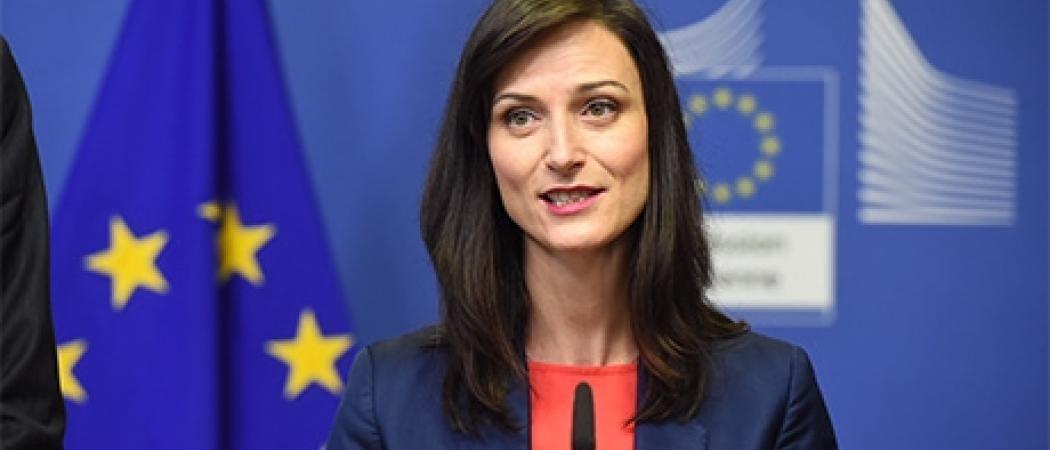Research commissioner Mariya Gabriel announces new push to coordinate with national policies and help EU13 countries boost their R&D performance

Mariya Gabriel. Photo: European Commission.
The European Commission is planning a “Widening 2.0” strategy to help newer member states boost their R&D performance and catch up with richer countries, the EU’s research and innovation commissioner Mariya Gabriel said on Tuesday.
The strategy will be based on the widening programme, a set of measures meant to boost cooperation between researchers in poorer and richer member states that will run as part of Horizon Europe.
The [research and innovation] divide among member states in Europe is larger than the gap in all the other economic indicators such as GDP, capital, employment, or productivity,” Gabriel told the commission’s research and innovation days online conference.
Gabriel said the widening scheme in Horizon Europe will be linked with other EU funds and programmes to finance investments in research and innovation in Europe’s underperforming countries and regions, and help researchers collaborate with teams from around the world without having to move permanently outside their countries. “We can really help our talented people to choose Europe, to stay, to choose their regions,” she said.
In 2019, EU research ministers agreed to allocate 3.3 per cent of the Horizon Europe budget to the widening programme. The provision is already enshrined into the Horizon legislation, while the budget for the other parts of the programme remains to be settled. The ring fencing was seen as a big victory for MEPs and countries behind a long-running push for a more level playing field in the R&D programme.
The latest EU innovation scoreboard shows that, with the notable exception of Estonia, R&D performance is below the EU average in all member states that joined the bloc after 2004. Widening 2.0 could help those countries catch up, but achieving this will require the commission to coordinate with national governments on national R&D budgets and on measures to dissuade researchers from leaving their home countries, by offering them better salaries and working conditions.
As of next year, member states will be allowed to spend up to five per cent of their structural funds on research and innovation projects that meet Horizon Europe’s excellence standards but fail to get grants because of the high level of competition for funds.
The commission hopes this will force member states to think beyond the usual infrastructure projects they choose to finance through structural funds.
The commission is also planning to relax state aid rules and allow member states to use structural funds to support SMEs and help them push cutting-edge discoveries to the market.
What is Widening 2.0?
Details on the new widening strategy are scarce at the moment, but Gabriel said it will revolve around six main concepts. First, the commission wants to help member states reform their R&D systems. Then, the plan would focus on improving connectivity in underperforming regions, attract talent, build capacities, strengthen links between science and business, and enable targeted research investments from structural funds.
But, said Gabriel, the question remains, “Now, how we can implement them, how we can operationalise these good intentions?”
Next week, Gabriel is due to publish a plan to shake-up the European Research Area (ERA), the long-standing ambition of the EU to create a single market for research.
Gabriel has recently sketched out her view of how the regions can play a greater part in getting member states to coordinate R&D policies and investments. It includes the launch of “ERA hubs”, regional organisations similar to EU’s digital innovation hubs, a project spearheaded by Gabriel in her previous mandate as commissioner for digital economy. The commission is hoping to replicate their success in the field of innovation and help poorer regions improve their R&D performance.
Gabriel also floated a new idea of “establishing close links” between ERA and the European Innovation Council (EIC). “It's time maybe to have a European Innovation Area,” she said, without giving further details about what this new mash-up would actually accomplish.
Replicate the recipe in western Balkans
To prevent the creation of another R&D performance fault line in the near future, the EU will attempt to target R&D investments in candidate countries in the western Balkans, said Olivér Várhelyi, commissioner for neighborhood and enlargement. “[The western Balkans] suffer from high unemployment while on the other hand, suffering the, the impact of brain drain,” he said.
Várhelyi is working with Gabriel on including research and innovation in a major economic development plan for the region, as part of their EU accession talks. Accession negotiations are already well underway with Montenegro and Serbia, but progress has been slower with Albania and North Macedonia.
According to Várhelyi, the plan will help the countries build “a more resilient knowledge-based future-proof economy”. To get the countries ready for EU’s digital and green transformations, the commission wants to halt the exodus of talent to ensure that knowledge will underpin their economies.
“For that we need innovative companies, we need start-ups, we need innovation hubs,” said Várhelyi, “to ensure that the investment is led by research and innovation.”





 A unique international forum for public research organisations and companies to connect their external engagement with strategic interests around their R&D system.
A unique international forum for public research organisations and companies to connect their external engagement with strategic interests around their R&D system.